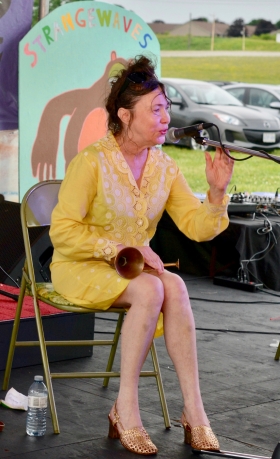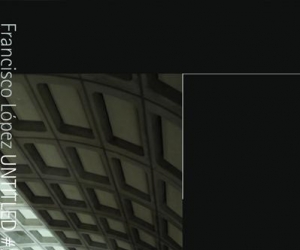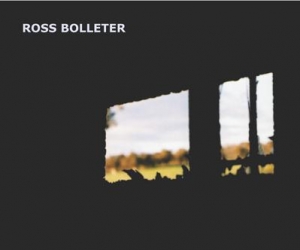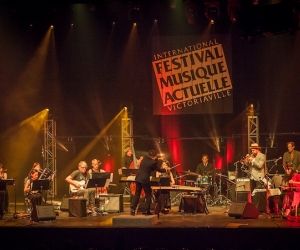On the last day of Strangewaves V, we drove onto the festival’s site at the fairgrounds in Paris, Ontario, a little after 2 p.m, when Myriam Gendron—a singer and guitarist best known for her 2014 release Not So Deep As A Well, which sets Dorothy Parker poems to fragile folk melodies—was scheduled to perform. Imagine my surprise when, upon getting out of the car, I heard the unmistakable sound of Matana Roberts’ saxophone. As I approached the tent that housed the stage and seated audience, the saxophone landed on a note that sounded strangely extended: was she experimenting with electronics? I began listening as Roberts told a story—casually, unaccompanied by any musical sound whatsoever—about her worst experience staying in a tent—a classic Airbnb story about finding the cheapest place in Memphis, Tennessee, only to discover that it was a tent in somebody’s backyard in, as Roberts put it, “the hood.” After a minute or two of this she picked up the sax again, hitting those unmistakable blues-grounded avant-jazz licks like few of her generation can, and landed on that same note again. Then came the hum again, which turned out to be, in fact, a hum: Roberts had instructed the audience to hum the note at the end of every phrase. As the performance continued she told stories about Europe and Halifax and about travelling on a cargo boat across the Atlantic, and ruminated about politics and privilege and punk houses and bliss, all of it punctuated by those sax improvisations.
Eventually, after bemoaning the fact that she had to leave to catch a plane (which, I assume, was the reason for the change in the schedule) she had the audience accompany her by humming a short soulful phrase that she riffed over, slowly fading out under rapturous applause.
The day before, in that same tent, we watched the Mary Margaret O’Hara Quartet—O’Hara on vocals, John Oswald on sax, Aidan Closs on drums and guitar, and O’Hara’s brother Marcus squeaking away on balloon—as we also watched the sky grow darker and darker. The band is tremendous, playing a kind of Dada-inflected free improv that seems genuinely free to do whatever it wants—make noise, play jazz, sing songs, banter awkwardly with the audience. It’s electric—but so are those flashes we keep seeing off in the distance. After half an hour, with the wind picking up and the sky looking downright apocalyptic, it seemed foolish to keep sitting there pretending nothing was happening. We rushed to our tent, packed it, and shoved it and ourselves into the car—and then the skies opened up. People ran around in a panic; organizers frantically tried to clean up the stage; tents started flying around and collapsing in heaps. We drove by the gate to find volunteers trying desperately to salvage the waiver forms all the campers signed (they might need them, we thought). We shoved their stuff in the car too and drove them over to the gym (the festival’s makeshift office), which was also entering a state of chaos. Later, on Instagram, I see that the guy from Wolf Eyes got a cut and had to be bandaged up. I read online that it was actually a tornado. Yet back in Paris the next day all I hear is that the party went on all night and everybody had a blast.
Those two episodes pretty much encapsulate the experience of Strangewaves. Now in its fifth year, and boasting a pretty high-profile slate of performers—which, in addition to the aforementioned experimentalists, included footwork legends RP Boo and Jana Rush; old folkie Bridget St John; weird Canadians Colin Fisher, Kee Avil, Doomsquad, Sarah Good and the Bads, and Isla Craig; and revered New York DJ Tim Sweeney—the festival remains resolutely DIY. The Hamilton, Ontario–based organization, which also runs events in the city throughout the year in addition to its annual music-and-camping extravaganza, receives no grants and no corporate sponsorship, and it shows—everything feels (and might actually be) improvised.
In addition to the music, Strangewaves boasts a host of installation art. Most notable was a womb (which my partner and I recognized immediately as such because there had been one just like it, all dangling red and purple cloth, set up at our hippie high school every December), in which all menstruating women in attendance were encouraged to congregate at sundown. A mysterious little altar was next to it, courtesy of Juliana LaChance; and the TrinkeTron—a sort of vending machine for odd objects—was inside the gym building, next to a young woman who spent the entire scorching hot pre-tornado Saturday constructing something shimmering and metallic on the wall that I never got to see in its completion. A market was also set up with vendors selling vintage clothes, artisanal aromas, and (I think) tarot readings. (Such banalities as, for example, a first-aid tent were not in evidence; what initially looked like one turned out to stock only sexual health zines and pamphlets and a truly heroic amount of condoms—as well as bug spray. We availed ourselves of the latter, and the volunteers confided that that’s all anybody had asked for from them all weekend.)
Yet as charmingly shambolic—and, frankly, tiny—as the festival was, Strangewaves’ programming is serious stuff. Past festivals have featured heavy hitters like the Sun Ra Arkestra, Laraaji, Lolina, Pharmakon, Moor Mother, and Buck Gooter. Its sensibility, which makes equal space for free jazz, folk, and footwork, not to mention noise and all manner of psychedelia, is not so much eclectic as omnivorous—less about delighting in jarring juxtapositions than about refusing to recognize stylistic difference at all, with a marked preference only for the extreme. That much it has in common with a swathe of other festivals including Halifax’s soon-to-be-renamed OBEY Convention, Montreal’s Suoni per il Popolo, Meaford, Ontario’s Electric Eclectics, and Calgary’s Sled Island. Also like them, but taken to an extreme, Strangewaves is proudly femme: both of the organizers, Becky Katz and Dallas Walzak, and all the volunteers I saw were women, and it must have the most female artists (and probably attendees) of any broadly speaking “experimental” festival I’ve attended.
This DIY, post-genre, explicitly feminist, more-than-a-little-chaotic sensibility certainly distinguishes Strangewaves and its ilk from older generations of festivals—which, to my mind, is all to the good. Maybe experimental music ought to feel a little dangerous.




